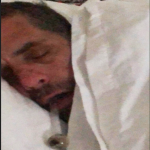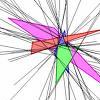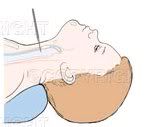AHI - Putting all eggs in one basket
- SuperGeeky
- Posts: 414
- Joined: Mon May 19, 2008 3:55 pm
- Location: MaryEtta, Gawga (Now a part of the Union)
AHI - Putting all eggs in one basket
I requested a copy of my Sleep Studies. My first gave me a overall score of 24 AHI.
Though, 24 is validating and enough to merit considerable attention and therapy. I just don't believe it to be a true indication of the overall severity of the problem.
The asteemed Inventor of the CPAP Device,Colin E. Sullivan, MD, PhD gave a speech a few years ago to this regard:
http://www.pulmonaryreviews.com/sep02/p ... Index.html
Though I'm new to all this, my bottom line is oxygen in the blood. Secondly, probably heart rate. That's it in a nutshell.
I'm more apt to put on a Oximeter all night and download the data for examination than to concentrate on seven day avg AHI.
I'm just too cynical after seeing a huge spike in heart rate and a huge dive in oxygen desaturation. What's the damage for such an event while off focusing on AHI?
Thanks,
SG
Though, 24 is validating and enough to merit considerable attention and therapy. I just don't believe it to be a true indication of the overall severity of the problem.
The asteemed Inventor of the CPAP Device,Colin E. Sullivan, MD, PhD gave a speech a few years ago to this regard:
http://www.pulmonaryreviews.com/sep02/p ... Index.html
Though I'm new to all this, my bottom line is oxygen in the blood. Secondly, probably heart rate. That's it in a nutshell.
I'm more apt to put on a Oximeter all night and download the data for examination than to concentrate on seven day avg AHI.
I'm just too cynical after seeing a huge spike in heart rate and a huge dive in oxygen desaturation. What's the damage for such an event while off focusing on AHI?
Thanks,
SG
-
mellabella
- Posts: 326
- Joined: Wed Dec 26, 2007 10:57 am
I'd put in my 2 cents for the UARS crowd: RERAs ("respiratory event related arousals", which aren't calculated into your AHI) matter too.
I had an AHI of just 5....but 42 arousals per HOUR, which meant I was never getting into REM, Stage 3, or Stage 4 sleep. At all. (Even with CPAP, I'm still only getting 5% REM, 3% Stages 3&4).
Doc says with a 50-60 pound weight gain, I'd probably get full on apneas instead of flow limitations (and thus get all the free prizes, heh, my insurer awards folks with OSA instead of UARS).
Either way, I'm still really $%#@ tired, and it absolutely has affected my general health and wellbeing. It turns out your body doesn't care why it's waking up (i.e. flow limitations vs. apneas) all the time, it's still just as miserable, and I was getting the same "oh no I'm suffocating" adrenaline spikes with those awakenings as folks with apneas, leading to elevated cortisol levels).
Though my 02 stats were nowhere near as bad as someone with OSA, luckily for me. I was only desaturating down to the 80s, so I was fortunate in that regard.
I had an AHI of just 5....but 42 arousals per HOUR, which meant I was never getting into REM, Stage 3, or Stage 4 sleep. At all. (Even with CPAP, I'm still only getting 5% REM, 3% Stages 3&4).
Doc says with a 50-60 pound weight gain, I'd probably get full on apneas instead of flow limitations (and thus get all the free prizes, heh, my insurer awards folks with OSA instead of UARS).
Either way, I'm still really $%#@ tired, and it absolutely has affected my general health and wellbeing. It turns out your body doesn't care why it's waking up (i.e. flow limitations vs. apneas) all the time, it's still just as miserable, and I was getting the same "oh no I'm suffocating" adrenaline spikes with those awakenings as folks with apneas, leading to elevated cortisol levels).
Though my 02 stats were nowhere near as bad as someone with OSA, luckily for me. I was only desaturating down to the 80s, so I was fortunate in that regard.
_________________
| Mask: Mirage™ FX Nasal CPAP Mask with Headgear |
| Additional Comments: UARS; pressure 15/19 |
-
Guest
Hey, MellaBella, I'm interested in how you determined your arousals. Was this done at your sleep study, or are you monitoring this at home?
I'm mystified by my reports, and can only quote my AHI (averages 2.1).
I'd be real interested in a "Reading and Comprehending Your Encore Pro Reports 101" class, if anyone's offering one.
I suppose that's included in the cost of an RPSGT, huh?
LOL,
Babs
I'm mystified by my reports, and can only quote my AHI (averages 2.1).
I'd be real interested in a "Reading and Comprehending Your Encore Pro Reports 101" class, if anyone's offering one.
I suppose that's included in the cost of an RPSGT, huh?
LOL,
Babs
-
mellabella
- Posts: 326
- Joined: Wed Dec 26, 2007 10:57 am
My arousal count was determined during my PSG at the lab....I don't forsee a home study in my near future, since they determine RERAs mostly by EEG activity, combined with the respiratory data.
I've wondered if that means an APAP would be useless to me, since I don't know how sensitive they are (really) at determining the level of flow limitations that create arousals for me.
I do know I've read online that BiPAP may be more effective for addressing treatment shortfalls with UARS, and given my new high pressure (13) I wouldn't mind testing the effect of exhalation relief, since I don't think an APAP would necessarily provide any treatment benefit for me. Other than leak rate, which I could really use, I don't know how much I'm missing out by not having a data capable machine as well.
Just my luck that BiPAPs seem to be the second most expensive option (next to VPAP). I'm hoping they keep coming down in price, just as other fancy electronics do. It seems like there are more affordable options out there just in the last couple years, from when I last looked at them.
I've wondered if that means an APAP would be useless to me, since I don't know how sensitive they are (really) at determining the level of flow limitations that create arousals for me.
I do know I've read online that BiPAP may be more effective for addressing treatment shortfalls with UARS, and given my new high pressure (13) I wouldn't mind testing the effect of exhalation relief, since I don't think an APAP would necessarily provide any treatment benefit for me. Other than leak rate, which I could really use, I don't know how much I'm missing out by not having a data capable machine as well.
Just my luck that BiPAPs seem to be the second most expensive option (next to VPAP). I'm hoping they keep coming down in price, just as other fancy electronics do. It seems like there are more affordable options out there just in the last couple years, from when I last looked at them.
_________________
| Mask: Mirage™ FX Nasal CPAP Mask with Headgear |
| Additional Comments: UARS; pressure 15/19 |
My sleep study gave RDI (respiratory distress index), which includes the RERAS, as opposed to AHI. I had more of the RERAS than anything else. Part of the comment at the bottom of my titration report was, "Optimum pressure - 9.0 cm eliminated OSA and REARS and maintained O2 baseline at 94 to 96%." We talked about the the UARS a lot after the sleep study.
Pam
Pam
_________________
| Machine: DreamStation 2 Auto CPAP Advanced with Humidifier |
| Additional Comments: Oscar Software | APAP: 9-10 |
Innomed Hybrid Mask
-
mellabella
- Posts: 326
- Joined: Wed Dec 26, 2007 10:57 am
[quote="WearyOne"]My sleep study gave RDI (respiratory distress index), which includes the RERAS, as opposed to AHI. I had more of the RERAS than anything else. Part of the comment at the bottom of my titration report was, "Optimum pressure - 9.0 cm eliminated OSA and REARS and maintained O2 baseline at 94 to 96%." We talked about the the UARS a lot after the sleep study.
Pam
Pam
_________________
| Mask: Mirage™ FX Nasal CPAP Mask with Headgear |
| Additional Comments: UARS; pressure 15/19 |
One metric can never fully describe a complex situation. On the other hand, we have to take what we can get.
I find it easier to conceptualize the situation by considering just the AI: It tells me how many times over the night I had "individual apnea events." (Well, sort of. Not always clear how things are counted when an "apnea event" starts during one "data minute" and continues into another "data minute". But that's being more fussy than it's worth.) Not a useless bit of information!
But it doesn't tell me anything about the duration of each apnea, or the overall percentage of the night when I was experiencing apnea. Or whether the apneas were all clustered together during a small portion of the night. Some of the commercially available software can provide, more or less, this additional information.
But then, what can we do with this sort of information? Not much, other than perhaps to compare outcomes of different therapy settings. After, of course, determining how variable these metrics are from night to night (for me, they're VERY variable!) and making sure that we collect sufficient data (I don't trust less than 20 observations) and carefully look at averages, medians, ranges, temporal trends (resulting from unidentifiable variables) and other relevant (or irrelevant) statistics.
Always remembering that a machine's definition of "apnea" may not be what we think is intuitively obvious, and that the "sensitivity" of different machines may differ.
Of course, as a self-proclaimed geek myself, I wouldn't tolerate not having access to such data. Helps to keep me interested, motivated, and busy. But I also recognize the limitations of the available metrics both in their own context, and in the context of their practical utility.
And then there are the more difficult or more expensive to obtain "physiologic" metrics. Pulse, oxygen saturation - fairly easy, if a bit costly. How about continuous BP monitoring (not even done during most sleep studies, since that can cause arousals), an issue clearly associated with sleep apnea? Why not EKG and ECG overnight? Well, now we're back to full-blown sleep studies.
Back to your issue about the "breathing" numbers. Is our concern primarily about our breathing? Or is our concern primarily about the quality of our sleep, and our "restedness" or "awakeness" during the day? Or is our concern primarily about the long-term cardiovascular consequences of sleep apnea. I think that the only rational answer is "all of the above."
Bottom lines:
A) What data are you willing to pay for?
B) What does the data mean (interpretation, consistency, sensitivity, etc)?
C) What are you going to do with the data?
AHI (or AI) is simply a metric which we can get simply. Let's make of it what we are able. But, I would suggest, not make more of it than it can tell us. It's barely something, and certainly not everything. It's a milepost along our path, arguably helpful in indicating which way we're heading, but without a lot of other data, it tells us only a little bit about where we are.
Unless we're in a position to actualy DO SOMETHING with the information, unless knowing MAKES A DIFFERENCE in our actions, then what difference does knowing make? I am an ardent supporter of data availability. I'm also an experienced data analyst. And I'm also more than a little obsessed with having information. But I do try not to let it make me crazy!
I find it easier to conceptualize the situation by considering just the AI: It tells me how many times over the night I had "individual apnea events." (Well, sort of. Not always clear how things are counted when an "apnea event" starts during one "data minute" and continues into another "data minute". But that's being more fussy than it's worth.) Not a useless bit of information!
But it doesn't tell me anything about the duration of each apnea, or the overall percentage of the night when I was experiencing apnea. Or whether the apneas were all clustered together during a small portion of the night. Some of the commercially available software can provide, more or less, this additional information.
But then, what can we do with this sort of information? Not much, other than perhaps to compare outcomes of different therapy settings. After, of course, determining how variable these metrics are from night to night (for me, they're VERY variable!) and making sure that we collect sufficient data (I don't trust less than 20 observations) and carefully look at averages, medians, ranges, temporal trends (resulting from unidentifiable variables) and other relevant (or irrelevant) statistics.
Always remembering that a machine's definition of "apnea" may not be what we think is intuitively obvious, and that the "sensitivity" of different machines may differ.
Of course, as a self-proclaimed geek myself, I wouldn't tolerate not having access to such data. Helps to keep me interested, motivated, and busy. But I also recognize the limitations of the available metrics both in their own context, and in the context of their practical utility.
And then there are the more difficult or more expensive to obtain "physiologic" metrics. Pulse, oxygen saturation - fairly easy, if a bit costly. How about continuous BP monitoring (not even done during most sleep studies, since that can cause arousals), an issue clearly associated with sleep apnea? Why not EKG and ECG overnight? Well, now we're back to full-blown sleep studies.
Back to your issue about the "breathing" numbers. Is our concern primarily about our breathing? Or is our concern primarily about the quality of our sleep, and our "restedness" or "awakeness" during the day? Or is our concern primarily about the long-term cardiovascular consequences of sleep apnea. I think that the only rational answer is "all of the above."
Bottom lines:
A) What data are you willing to pay for?
B) What does the data mean (interpretation, consistency, sensitivity, etc)?
C) What are you going to do with the data?
AHI (or AI) is simply a metric which we can get simply. Let's make of it what we are able. But, I would suggest, not make more of it than it can tell us. It's barely something, and certainly not everything. It's a milepost along our path, arguably helpful in indicating which way we're heading, but without a lot of other data, it tells us only a little bit about where we are.
Unless we're in a position to actualy DO SOMETHING with the information, unless knowing MAKES A DIFFERENCE in our actions, then what difference does knowing make? I am an ardent supporter of data availability. I'm also an experienced data analyst. And I'm also more than a little obsessed with having information. But I do try not to let it make me crazy!
SG & Velbor...........
I think both of you are right on the point. O2 saturation is the bottom line and AHI is an imperfect indicator.
Being a cross between a geek and a mechanic, I've taken the position that using AHI data and Oximeter data....together....is the most economical...and effective....path to take.
SG.....I suggest that you obtain a recording Oximeter....set the sample rate on 2-second intervals....and study yourself for a week or so. You'll be amazed by what you learn.
My experiments (on myself) indicate that I'm not getting sufficient O2 unless my AHI is running below 2.5.....that's HALF what the medical industry says is "normal".
After almost 2-years on the hose, I've come to the realization that....for the most part.....the "sleep center industry" pretty much just "slops it out".....giving crappy service....while milking the payment systems for every penny.
My therapy has been 98% "do it myself".........and I'm successful. I'm running a fully-data-capable M-Series, a SPO-7500 Oximeter with SPO software, and a drugstore-purchased blood pressure checker. Those three tools tell me what I need to know.......at a cost that's not excessive.
I'm doing great......and I enjoy my CPAP with C-FLEX every night.
Gerald
I think both of you are right on the point. O2 saturation is the bottom line and AHI is an imperfect indicator.
Being a cross between a geek and a mechanic, I've taken the position that using AHI data and Oximeter data....together....is the most economical...and effective....path to take.
SG.....I suggest that you obtain a recording Oximeter....set the sample rate on 2-second intervals....and study yourself for a week or so. You'll be amazed by what you learn.
My experiments (on myself) indicate that I'm not getting sufficient O2 unless my AHI is running below 2.5.....that's HALF what the medical industry says is "normal".
After almost 2-years on the hose, I've come to the realization that....for the most part.....the "sleep center industry" pretty much just "slops it out".....giving crappy service....while milking the payment systems for every penny.
My therapy has been 98% "do it myself".........and I'm successful. I'm running a fully-data-capable M-Series, a SPO-7500 Oximeter with SPO software, and a drugstore-purchased blood pressure checker. Those three tools tell me what I need to know.......at a cost that's not excessive.
I'm doing great......and I enjoy my CPAP with C-FLEX every night.
Gerald
Re: AHI - Putting all eggs in one basket
After 100 days of CPAP, I am certainly only a newbie, too, but I think your premise is totally wrong.SuperGeeky wrote:I requested a copy of my Sleep Studies. My first gave me a overall score of 24 AHI.
Though I'm new to all this, my bottom line is oxygen in the blood. Secondly, probably heart rate. That's it in a nutshell.
The score has little to do with it, either you have Sleep Apnea or you don't. The good Dr said that scores less than 20 may or so may not be predictive, but if you had apneas during the sleep study, then you HAVE SLEEP APNEA.
I also have a recording oximeter and it is a handy tool in conjunction with the auto cpap machine. Basically, little has been seen on the oximeter when the cpap is working properly. Buy both and give it a try, but the real therapy and measurement seems far more accurate and meaningful from the cpap data. YMMV.
_________________
| Machine: AirCurve™ 10 VAuto BiLevel Machine with HumidAir™ Heated Humidifier |
| Mask: Fisher & Paykel Vitera Full Face Mask with Headgear - Fit Pack (All Sizes Included) |
| Additional Comments: Titrated on Auto CPAP at 7/14 cm: Only licensed medical professionals can give medical advice or write prescriptions |
- DreamStalker
- Posts: 7509
- Joined: Mon Aug 07, 2006 9:58 am
- Location: Nowhere & Everywhere At Once
Well, my fellow geeksters have said it well. The AHI numbers are not perfect but they are a lot more perfect than no data at all.
The sleep medicine profession seems to focus on mitigating snoring and enhancing sleep quality rather than the more fatal effects of OSA on our CVS and other related health issues arising from OSA like hormonal imbalances and cell destroying inflamation that lead to diabetes, obesity and accelerated aging and disease.
As has already been said, one extra metric that we can monitor is the O2 saturations and I think the continuous (actualy high resolution) recording oximeters available to us from online vendors are well within affordable range when we consider the cost of a vacation trip or flat panel HDTV weighted against our much more precious health.
The sleep medicine profession seems to focus on mitigating snoring and enhancing sleep quality rather than the more fatal effects of OSA on our CVS and other related health issues arising from OSA like hormonal imbalances and cell destroying inflamation that lead to diabetes, obesity and accelerated aging and disease.
As has already been said, one extra metric that we can monitor is the O2 saturations and I think the continuous (actualy high resolution) recording oximeters available to us from online vendors are well within affordable range when we consider the cost of a vacation trip or flat panel HDTV weighted against our much more precious health.
President-pretender, J. Biden, said "the DNC has built the largest voter fraud organization in US history". Too bad they didn’t build the smartest voter fraud organization and got caught.
-
Guest
Okay, here's a tangent question..... How do I get my AHI to Zero?
My dear friend 6ptStar thinks I'm gonna die in my sleep because I'm averaging 2.1 AHI.
Mask doesn't leak, mouth doesn't leak, what the heck am I supposed to do? Keep playing with my pressure?
If the answer involves daily downloads, I'm probably not going to do that. Which is why I'm settling for 2.1.
Thanks!!!
Babs
My dear friend 6ptStar thinks I'm gonna die in my sleep because I'm averaging 2.1 AHI.
Mask doesn't leak, mouth doesn't leak, what the heck am I supposed to do? Keep playing with my pressure?
If the answer involves daily downloads, I'm probably not going to do that. Which is why I'm settling for 2.1.
Thanks!!!
Babs
Well, I guess I'm going to TRY to look at my data daily.
Going to re-set my pressure to 11 - which seems to have been my lowest AHI point - and try that for a week and see what I get. Then adjust something else and try THAT for a week.
Blech. Where's the CPAP fairy to come go PWRONG! and make it all work perfect?
LOL,
B.
Going to re-set my pressure to 11 - which seems to have been my lowest AHI point - and try that for a week and see what I get. Then adjust something else and try THAT for a week.
Blech. Where's the CPAP fairy to come go PWRONG! and make it all work perfect?
LOL,
B.
_________________
| Machine: PR System One REMStar 60 Series Auto CPAP Machine |
| Additional Comments: Started XPAP 04/20/07. APAP currently wide open 10-20. Consistent AHI 2.1. No flex. HH 3. Deluxe Chinstrap. |
I currently have a stash of Nasal Aire II cannulas in Small or Extra Small. Please PM me if you would like them. I'm interested in bartering for something strange and wonderful that I don't currently own. Or a Large size NAII cannula. 
[quote="mellabella"][quote="WearyOne"]My sleep study gave RDI (respiratory distress index), which includes the RERAS, as opposed to AHI. I had more of the RERAS than anything else. Part of the comment at the bottom of my titration report was, "Optimum pressure - 9.0 cm eliminated OSA and REARS and maintained O2 baseline at 94 to 96%." We talked about the the UARS a lot after the sleep study.
Pam
Pam
_________________
| Machine: DreamStation 2 Auto CPAP Advanced with Humidifier |
| Additional Comments: Oscar Software | APAP: 9-10 |
Innomed Hybrid Mask
My understanding (probably flawed, certainly not "expert") is that an AHI below 5 is generally considered "normal" (whatever that word is supposed to mean) and that if it is that low without using something to GET it that low, you do not have obstructive sleep apnea (as far as the doctors are concerned, anyway) even if you still have some apneas overnight.
If a person has been diagnosed OSA and is being treated, I don't think there is any need for that person to worry too much about trying to get a zero AHI, although it is always cool to try to get it as low as one can--just for the principle of the thing.
If a person can get the AHI consistantly below 5, I hear that that is cause for that person to do a little snoopy happy-feet dance every morning from that point on. But minor flow restrictions can be counted by some machines in figuring the AHI, which may make the AHI number misleadingly high now and then.
Just stuff I think I've read in other posts somewhere.
jnk
If a person has been diagnosed OSA and is being treated, I don't think there is any need for that person to worry too much about trying to get a zero AHI, although it is always cool to try to get it as low as one can--just for the principle of the thing.
If a person can get the AHI consistantly below 5, I hear that that is cause for that person to do a little snoopy happy-feet dance every morning from that point on. But minor flow restrictions can be counted by some machines in figuring the AHI, which may make the AHI number misleadingly high now and then.
Just stuff I think I've read in other posts somewhere.
jnk















